1lumen selects and reviews products personally. We may earn affiliate commissions through our links, which help support our testing.
FireFlies PL47G2 2021 review
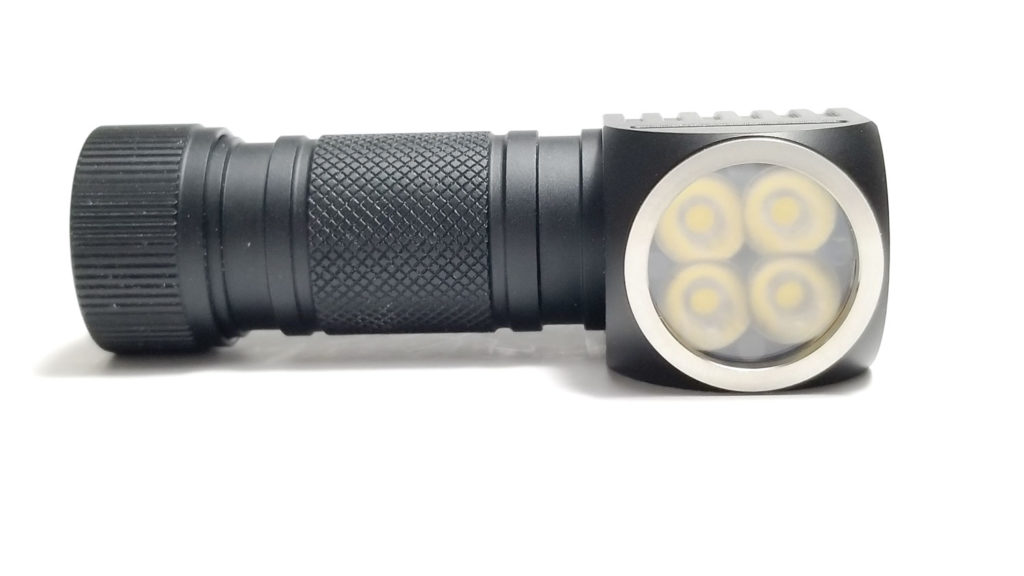
FireFlies PL47G2 2021 specifications
| Brand/model | FireFlies PL47G2 2021 Version |
|---|---|
| LED | 4x Luminus SST20 FA3 4000K 95 CRI |
| Lumens | 2800 lm |
| Beam intensity | N/A |
| Battery config. | 1*21700 or 1*22430 with short tube |
| Material | Aluminum |
| Modes | Many! Runs Anduril firmware |
| Blinkies | Many |
| Reflector | TIR optics |
| Waterproof | IP68 |
| Review date | September 2021 |
Introduction:
FireFlies is a name that’s been around the block a few times. No, not the flying beetles sporting bioluminescent body parts. I’m talking about the Chinese flashlight company, and honestly, I don’t know too much about them. I do know they have been a familiar fixture in the flashlight enthusiast continuum since early 2018 when they surprised the heck out of everyone with the FireFlies ROT66. This was a soda can light with 9 emitters behind TIR optics. Soda can lights were nothing new, but the ROT66 clearly catered to the enthusiast camp as it was available with a variety of popular emitters in various tints and bins.
However, what made it special is you could get it with the holy grail of tint snobberism Nichia 219B D220 SW45K 9080, which also made the ROT66 the only (at the time) factory light to come with the SW45K emitter. Following the ROT66 came the L-shaped PL47, a quasi-EDC/headlamp contraption with a quad emitter arrangement behind a Carclo TIR optic. Again, Fireflies was generous with the emitter choices, ranging from Luminus SST20’s, Nichia 21B, and Cree XP-L Hi. With between 2500 and 5000 Lumens with the new Anduril UI, it was also the brightest headlamp around. After some initial delays due to “quality instability”, the PL47 was re-released as the FireFlies PL47 G2 model. A few months ago, FireFlies released a new version, or is it? Either way, they sent one out to test on, so a big thanks to them. Let’s see how well the PL47 G2 2021 edition has aged.
Package quality.
The PL47G2 2021 version came in a nice, premium-looking package. On a value scale, I’d say Fireflies is up there with Lumintiop or Emisar. Not ultra-budget, but not ultra-expensive either. I like the layout and inside everything is nicely laid out and more importantly, well protected. The outside of the box is pretty spartan, with just the branding and a sticker on one end with the build date, emitter type, body color, and a quality inspector mark. The review light came nicely kitted out with optional extras, so I probably got more than the average buyer would get. The light itself was nestled in dense foam at the bottom, with the accessories riding on top.
- FireFlies PL47G2 2021 (with optional 22430 tube installed
- Spare o-rings (2 for the short, 2 for the long tubes)
- 22430 li-ion cell (installed in the light)
- UI manual
- Pocket clip
- Lanyard with quick-release clip
- Headlamp headband
- 21700 tube
This is a really nice assortment of accessories, and the optional extras are a very nice addition. Depending on how you bundle this (with short tube+battery or 21700 tube, with or without battery), you get everything you need. The accessories are just okay. The lanyard is kind of junky and cobbled together by melting the cut ends and fusing them. Definitely out of place on a somewhat-upscale light (even Sofirn’s lanyards are nicer…just saying).
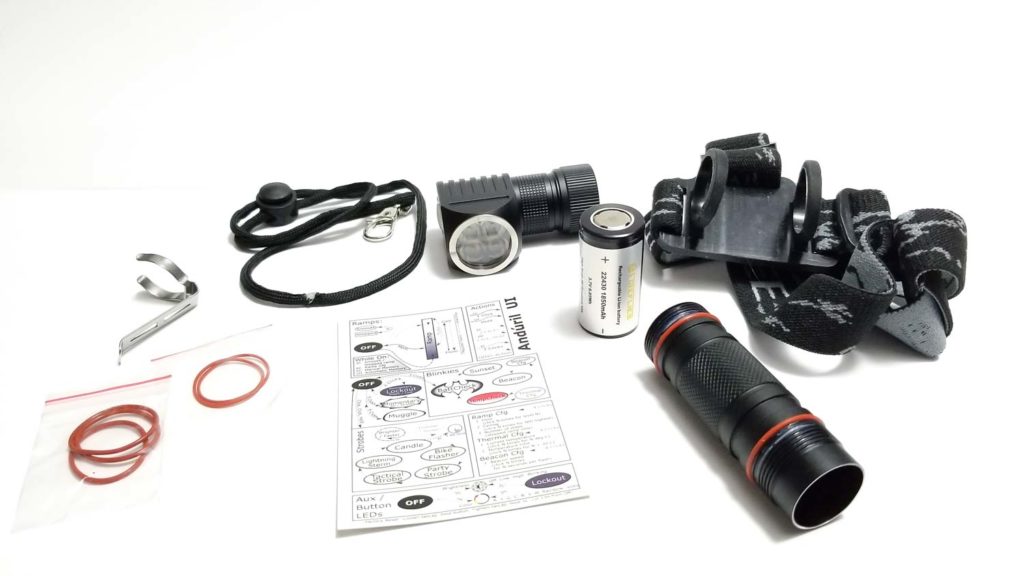
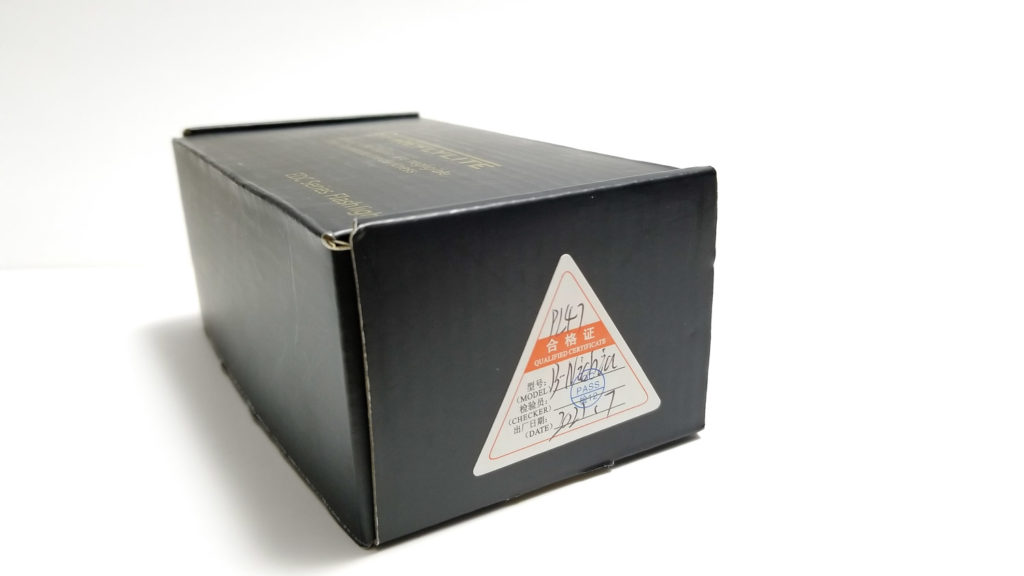
Flashlight in use
The Fireflies PL47G2 2021 is primarily a right-angle EDC light (like the Lumintop HL18), but also functions as a headlamp when you put it in the included headband. This is nice for versatility. From a handling perspective, I can’t say it does one task better than the other though. Is this a headlamp or an EDC light, or both? As a handheld flashlight, it’s nice to hold, and I found the best way was holding it in a pistol grip of sorts, with your thumb resting on the top of the head (which is where the switch is located). With the short 22430 tube installed, handling is a bit awkward since the light is top-heavy and the head sticks out quite a bit to accommodate the optic. It’s also front-heavy.
You’re restricted to holding it with a 2 finger grip on the 22430 size short tube, but switching to the 21700 tube allows a full grip and helps with balance. The head has some shallow heatsinking fins, and the battery tube has diamond cut knurling (the first G2 had none), that’s kind of shallow and not super-aggressive, but works. The tailcap has fine reeding for grip (you need it, trust me). The e-switch is mounted on the top of the head, and the click action is good, with positive clicks and good feedback. The action is low though. It’s mounted in an indentation with an aluminum bezel, so finding it is super easy. It’s also backlit in a nice white glow, with 4 white SMD LEDs. When the light is off, all 4 are illuminated, but when on, only 2 are illuminated which is a nice feature.
The 21700 tube has grooves milled in for an optional pocket clip, which can be mounted to the tube for bezel up or down pocket carry or clipping to clothing, belt, backpack, etc., or you can use it as a headlamp. Unfortunately, you can’t use the clip with the 22430 tube. You can also attach a lanyard to the tailcap, which has an appropriately-sized lanyard hole using the included quick-release lanyard. Lots of retention or carry options for the PL47! The headband setup has a flexible silicone mount for the headlamp and is comfortable to wear with the added top strap to help with stability if using it on a helmet. A major drag here is the headband mount is only compatible with the long 21700 tube, since you need the long tube to span the 2 open hoops that fit into the grooves in the tube. Fitting the tube into the mount is tricky since you kind of have to force and finesse it in there, but once installed, it works fine. The headband is comfortable to wear and the PL47 rotates freely 90 degrees up or down in the mount.
The tailcap has a pretty strong magnet behind the spring PCB that grips the battery and helps pull it out of the tube, as well as holding the light at a 90 degree angle with good stability. Tail standing is feasible, but it’s wobbly. I am usually NOT a fan of magnetic tailcaps on EDC lights since anything ferrous in your pocket (keyrings, etc) sticks to the magnet, but I am really digging the usefulness it adds to the PL47, especially as a worklight when you need your hands free.
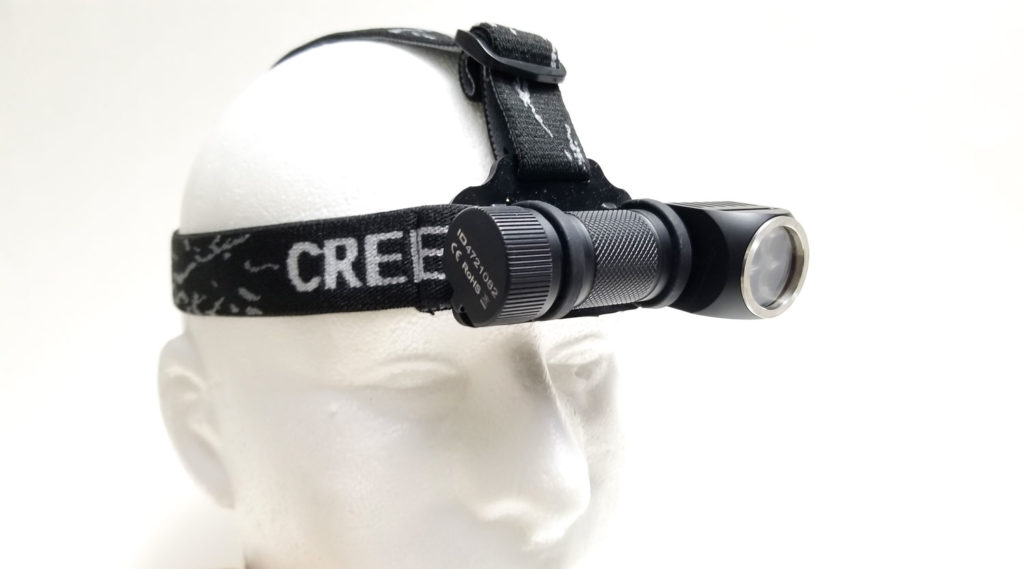
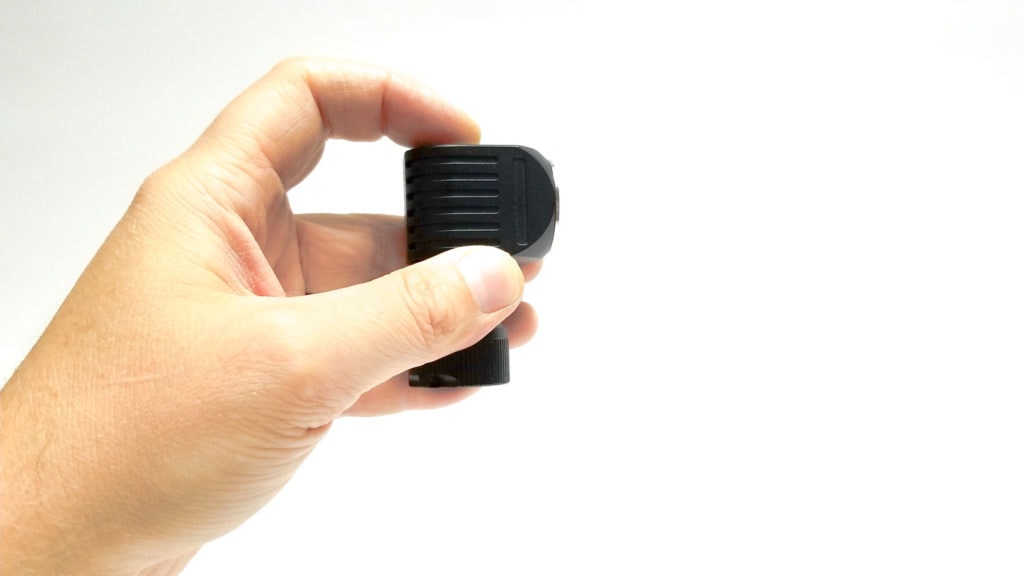
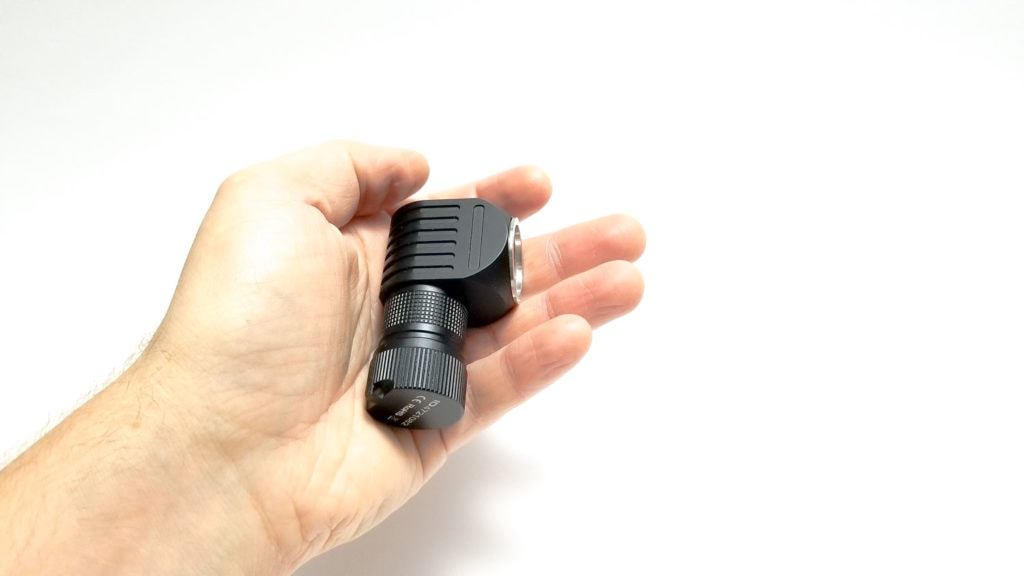
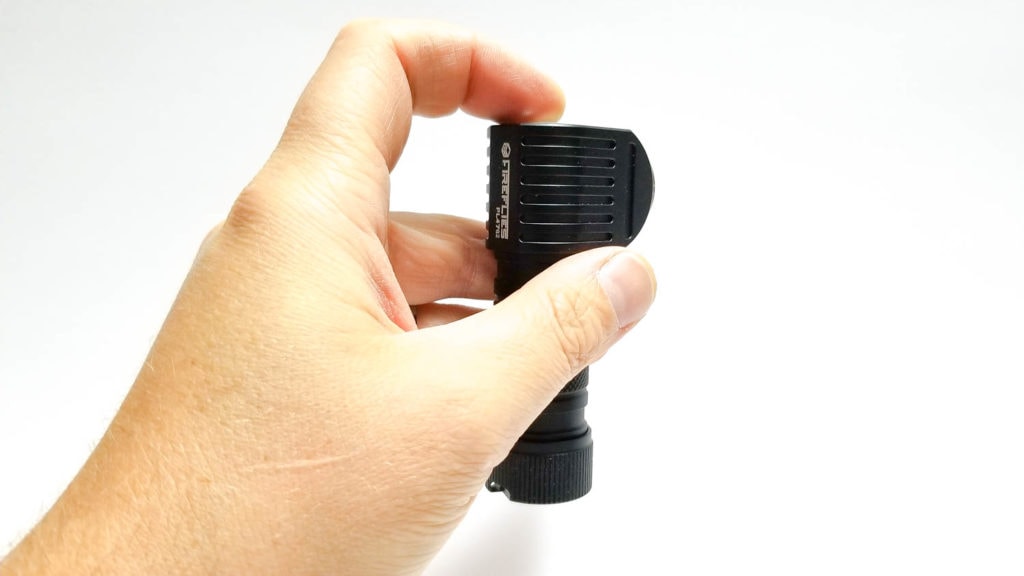
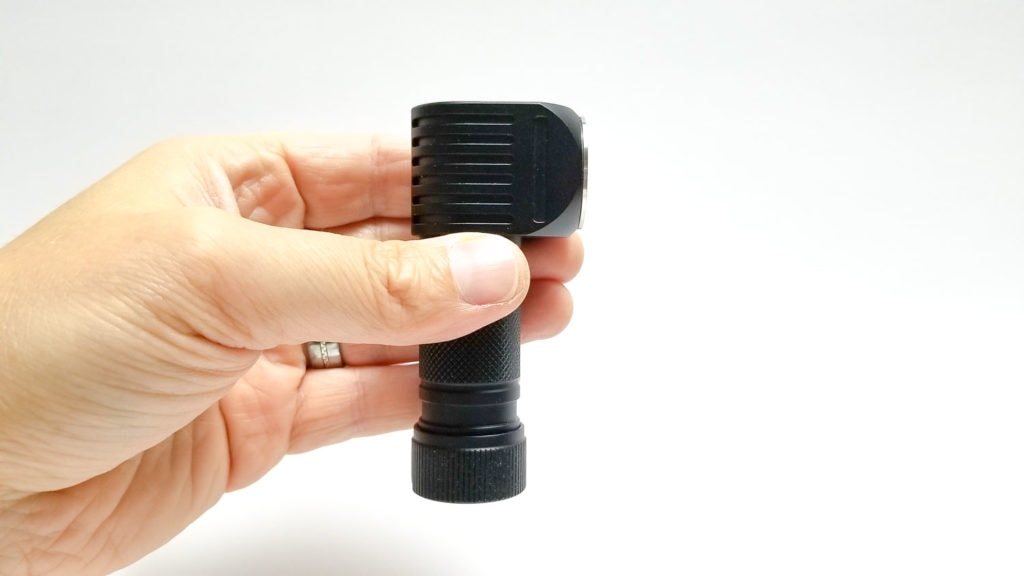

Build Quality, and Warranty
Since this is the first FireFlies product I’ve reviewed, I can say that the fit and finish are as good as any other light in this price range. These start at $49 US, and fully optioned with XP-L Hi’s (adds $20), short tube and 22430 battery (+$15), you’re looking at around $75-$80 US. That seems like a lot, but I think Bob Barker would agree with me that the price is right.
The light is made from 6061 aluminum alloy, and the build quality is nice. The machining had no tool or machine marks, chips or blemishes, and all the parts fit together fine with no gaps. The texturing on the battery tubes are nicely done, and the reeding on the tailcaps is nice. There’s no sharp edges either. The finish? The G2 came in black type III HA, but you can also get it in a groovy red finish (FireFlies also sent over the new mule version of the PL47 in red). It’s a matte finish, and although it’s nice, it’s not quite as nice as matte finishes like I get from Convoy, Acebeam or Cyansky. I did notice some glue had escaped from the edge of the driver where they glued it down, and there was some hardened sealant or something on the inner threads on the head. I was able to scrape off the glue and sealant with a pick. The glue was on the driver’s contact ring, and that can cause potential connection issues.
The only removable part is the battery tube and tailcap. The bezel seems pressed on, and there’s no retaining rings anywhere, so no modding. There are o-rings sealing the bezel, and thick o-rings sealing both ends of the 21700 tube, but smaller ones sealing the 22430 tube. Apparently, this is good enough for an IP68 rating. The threads are nice and stout square-cut deals on both ends of the battery tubes. The part that threads into the head is a unique design with a long, unthreaded section that contacts the driver. My guess is this helps with heat sinking due to added contact with the head.
Some of the threads on the tubes were lubed with a thick synthetic grease (that seemed almost dried up), but some were bone-dry, and for the first several times I unscrewed the tailcap and battery tubes, it was remarkably difficult and I had to use my He Man grip. I threw on some SuperLube and it helped a ton (folks, lube is your friend). The threads themselves are rectangular cut and appropriately sized.
Smoothness? Yep, but again, I recommend some good synthetic grease. The springs on the tailcap and driver look to be high current BeCu units that FireFlies is putting on their lights these days to reduce resistance. Nice!
While not as robust as other higher-end manufacturers, FireFlies warranty is still pretty good. From the website: “We provide 3 years’ manufacturer warranty to fireflies flashlights. (Consumable batteries are not in warranty). DOA products can be returned and refunded within 15 days, we will bear all the returning shipping cost.”
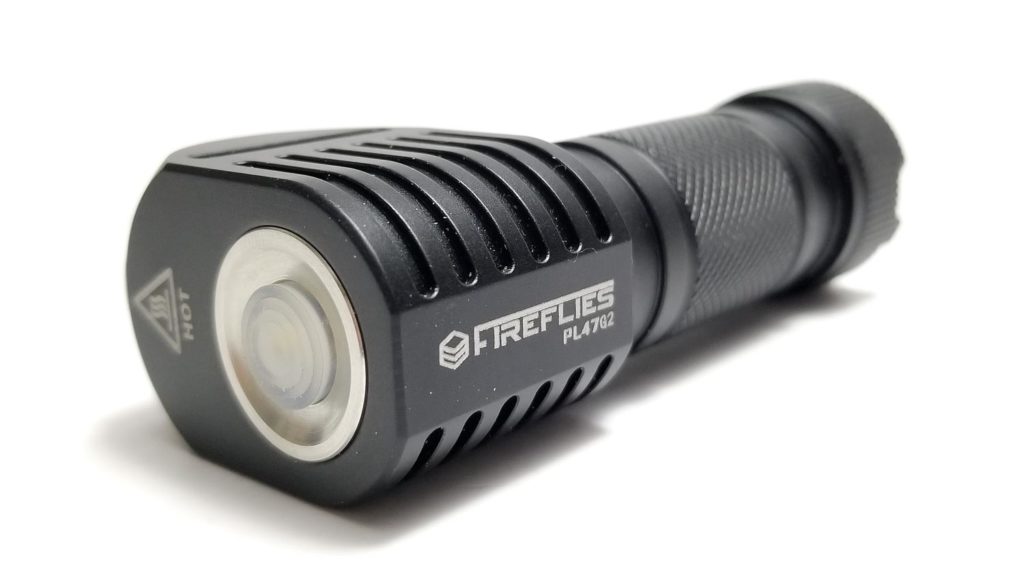
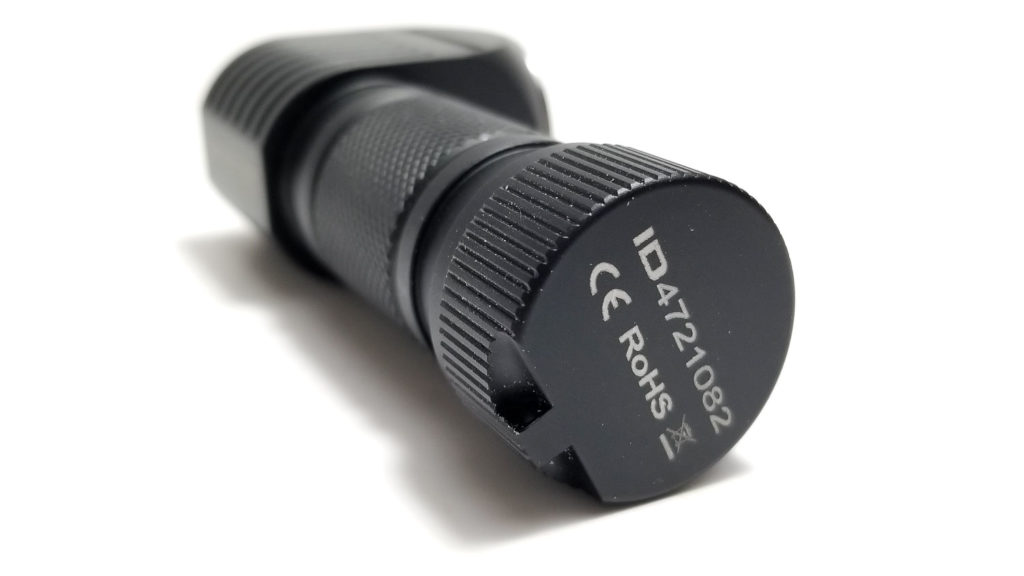
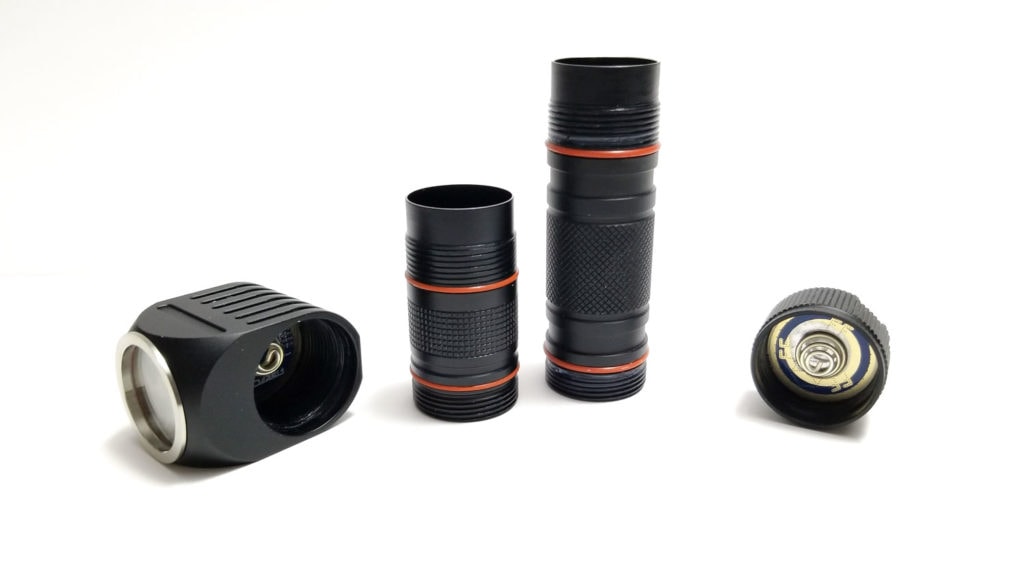
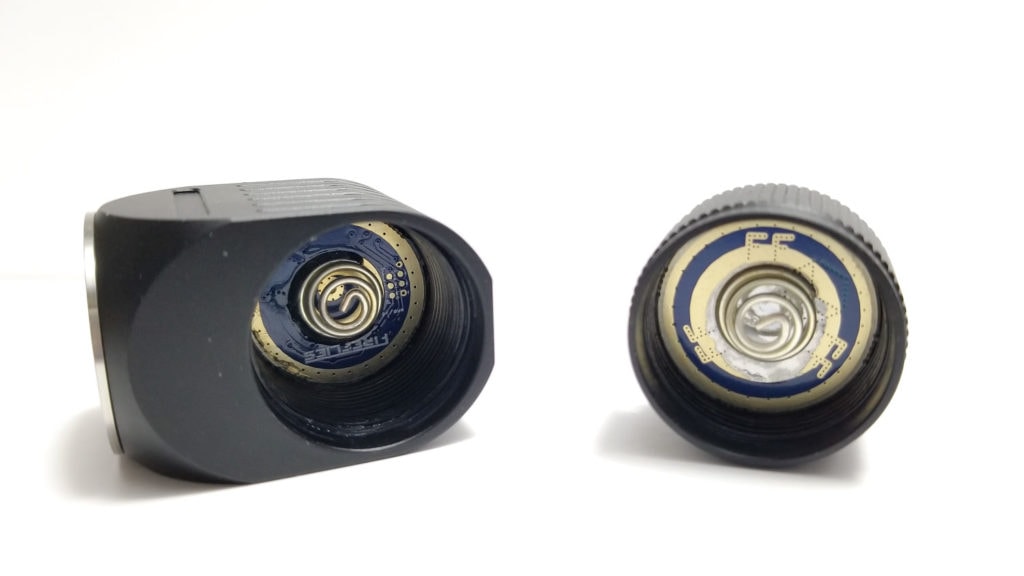
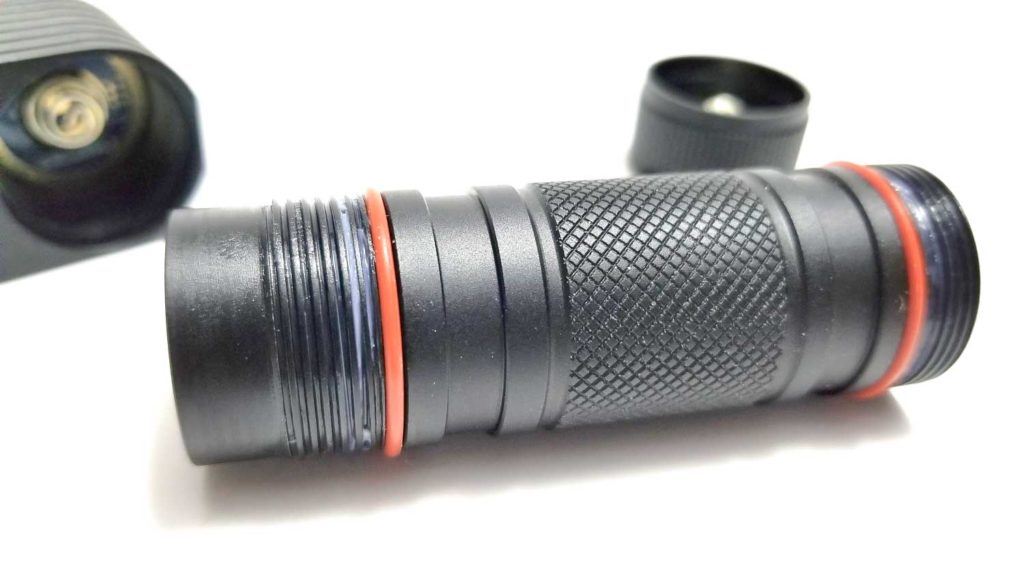

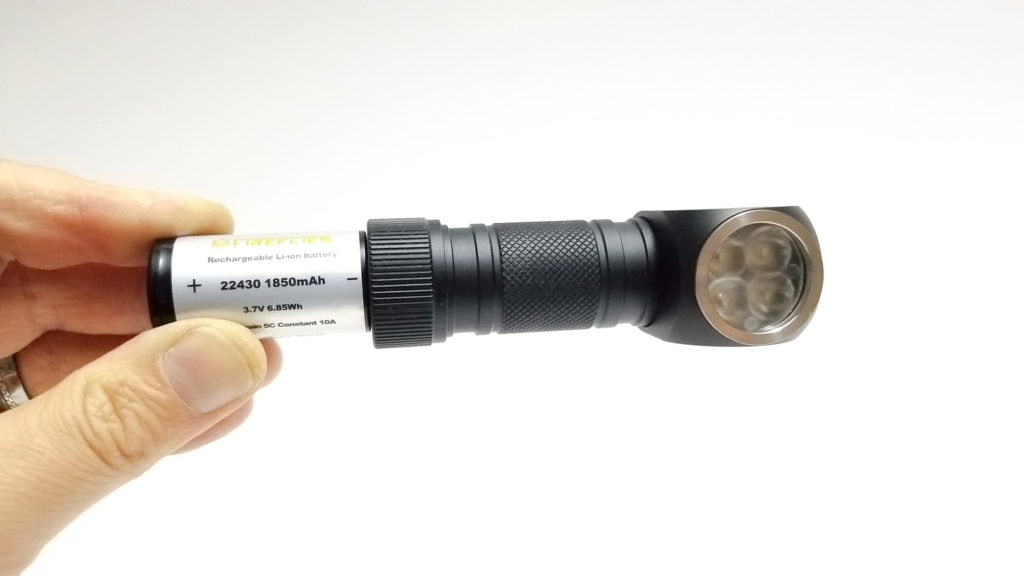
LED, Lens, Bezel, and Reflector
The PL47G2 2021 edition still employs a quad emitter configuration behind TIR optics, and has a variety of emitter options available. The standard equipment consists of the Luminus SST20 FA3 4000K 95 CRI, the SST20 10W 5000K, or the tint snob’s favorite Nichia 219B D220 SW45K 4500K high CRI. If SST20s or 219Bs aren’t your thing, Cree XP-L Hi V3 1A 6500K, V3 3A 5000K, or V2 5A 4000K emitters are an optional extra.
My sample(s) came with the FA3 SST20. Now, I am in no way shape or form a tint-conscientious individual and prefer output and beam quality over tint and CRI. That said, I do like nice tints, and these were a bit rosier than some other 4000K SST20’s I’ve reviewed and less warm than I’m used to. I’d venture that these are closer to 4500K. Otherwise the tint is nice and not green at low current. The optics are a Carclo-type frosted TIR optic with SMD aux LEDs behind it. These vary in color based on the body color: Ice blue for the black body, and vivid purple for the red body. The bezel is a small stainless steel ring, and the optics are protected by a mineral glass lens with AR coating. In my testing, the stock optic produces a balance of mostly flood, but some throw. The hotspot is mostly there, but mainly surrounded by diffuse spill and I think it’s enough to be useful, but don’t plan on seeing past a couple hundred meters, even on Turbo. If you just want a wall of light, FireFlies also sells a mule version without an optic.

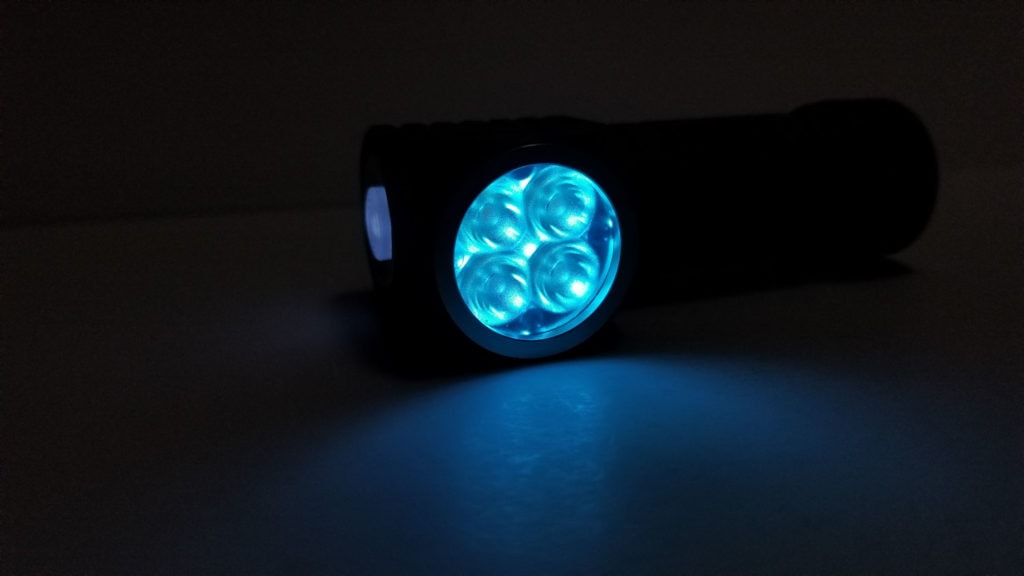
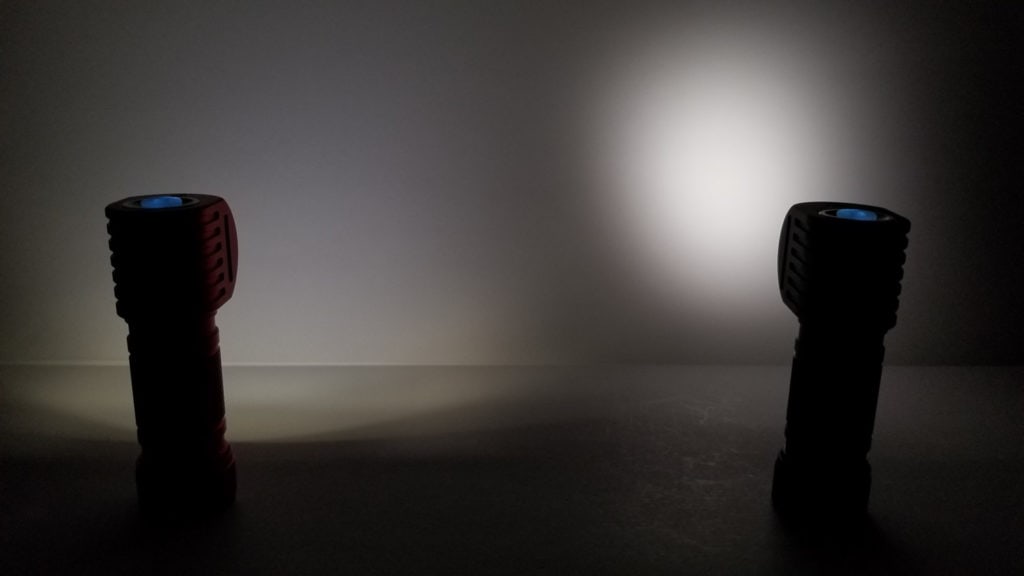
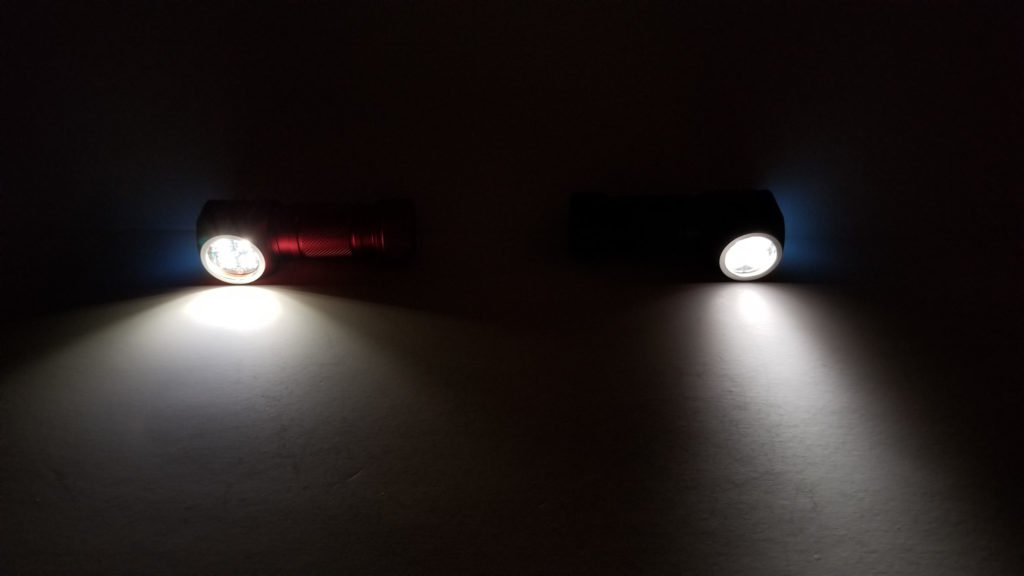
Dimensions and size comparison
- Length with 21700 tube: 8.9 cm / 3.14 inches. With 22430 tube: 6.45 cm / 2.53 inches
- Height: 4 cm / 1.57 inches
- Width (body): 2.8 cm / 1.10 inches
Weight:
- 22430 tube without battery: 73 grams / 2.57 oz.
- 22430 tube with included 1850 mAh battery:114.6 grams / 4.04 oz.
- 21700 tube with Epoch 50G 21700: 149.7 grams / 5.28 oz.
- 21700 tube without battery: 80.4 grams / 2.83 oz.
Flashlight comparison
Compared the PL47G2 to some other headlamps and EDC flashlights.
Headlamps left to right: Cyansky HS6R, FireFlies PL47G2 Mule version, Slonik D10.
Group 2: PL47G2, Astrolux EA01, Thorfire C8.
Group 3: EDC lights left to right: PL47G2, Lumintop FWAA.
I also compared the short 26650 version of the EA01 to the 22430 version of the PL47G2, and a side by side between the optic PL47 and mule version.
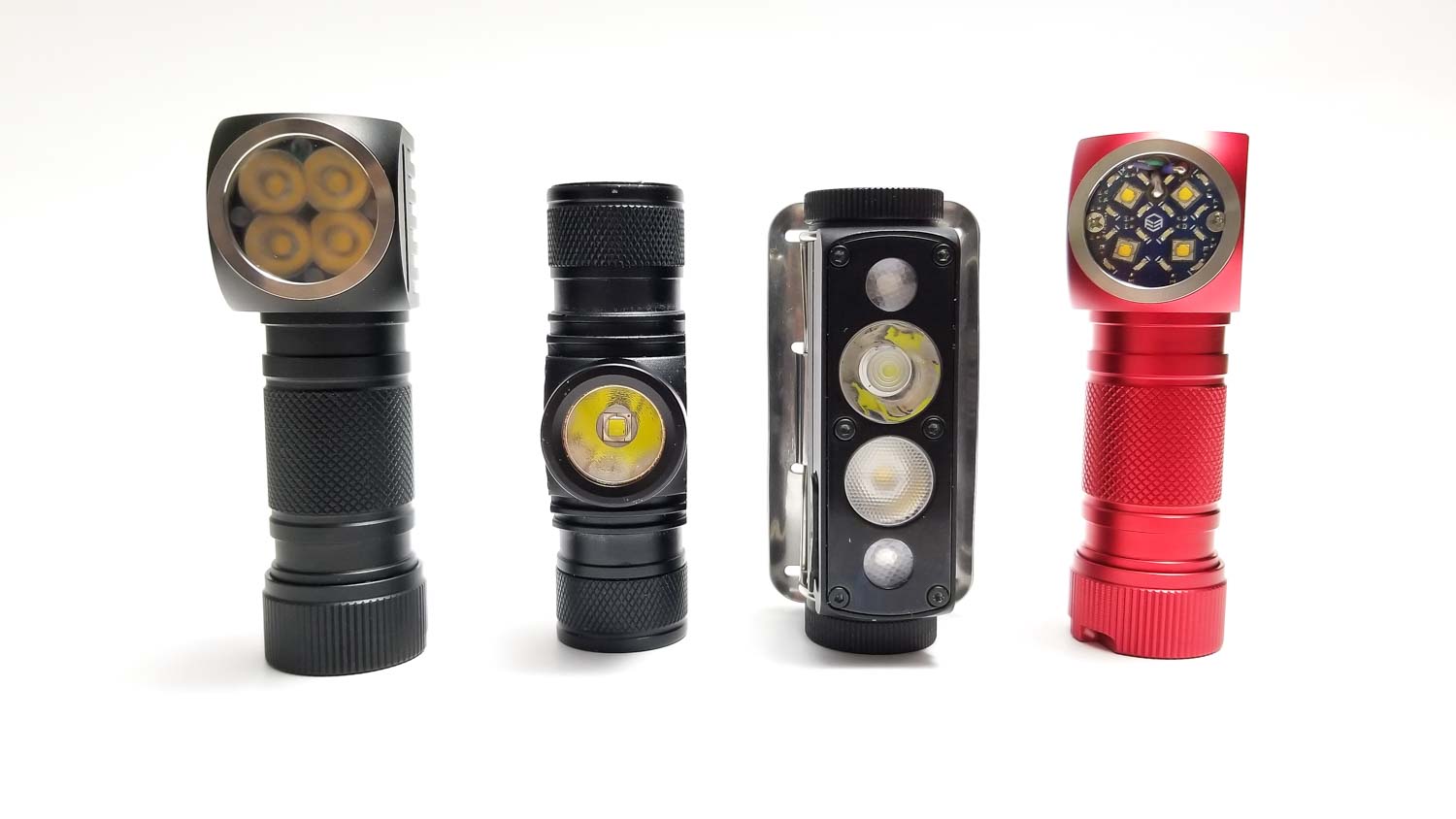

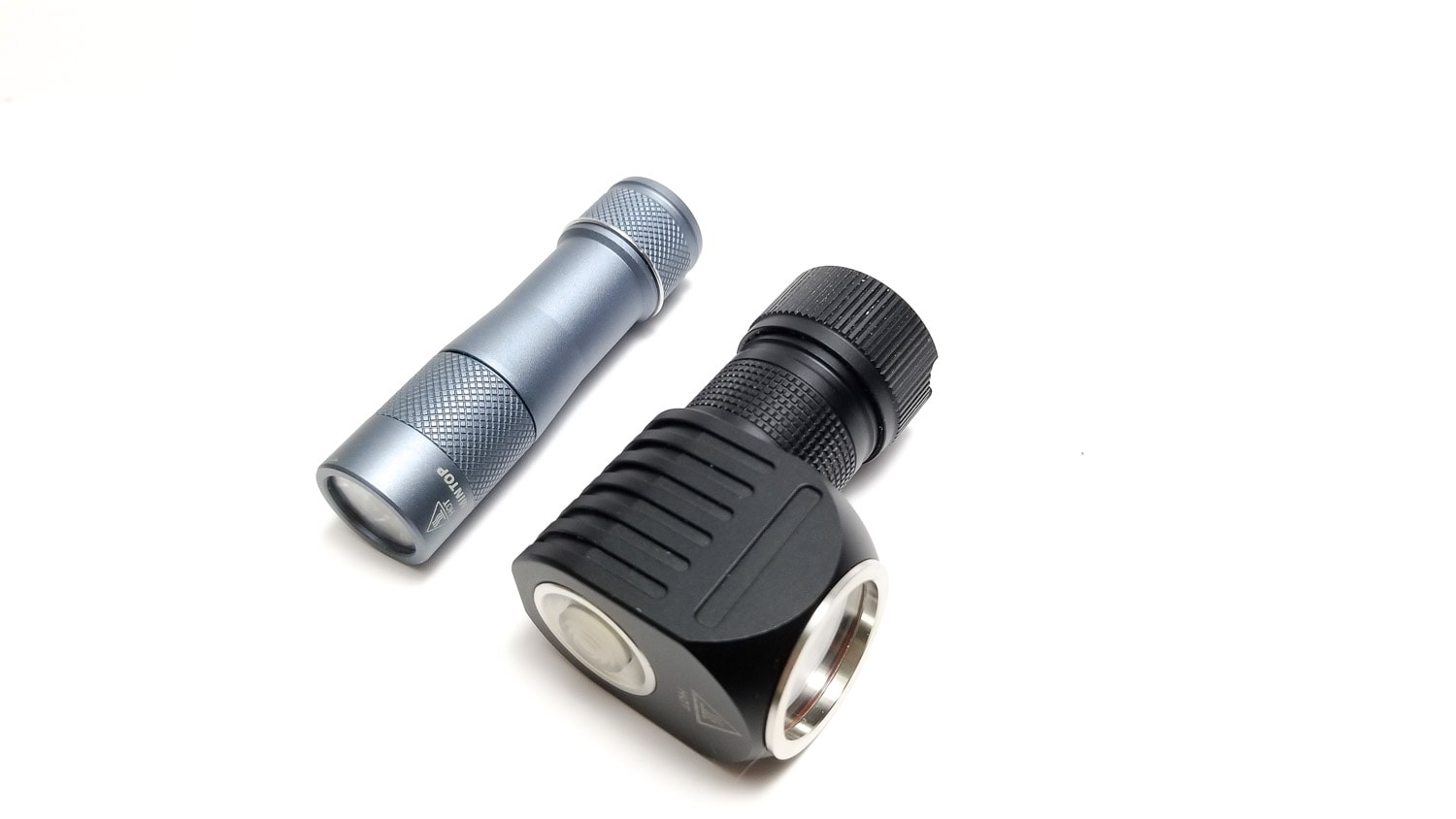
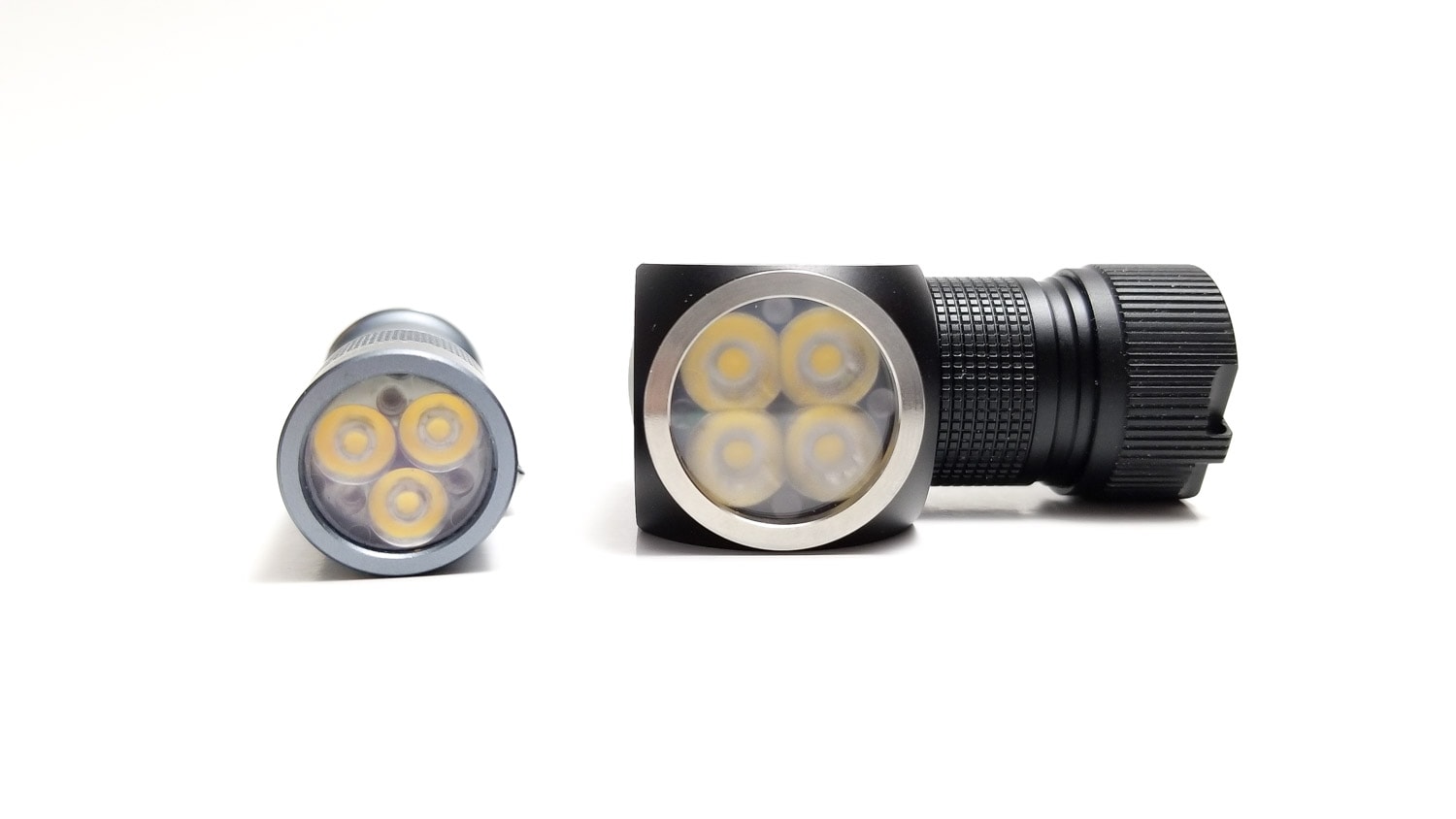
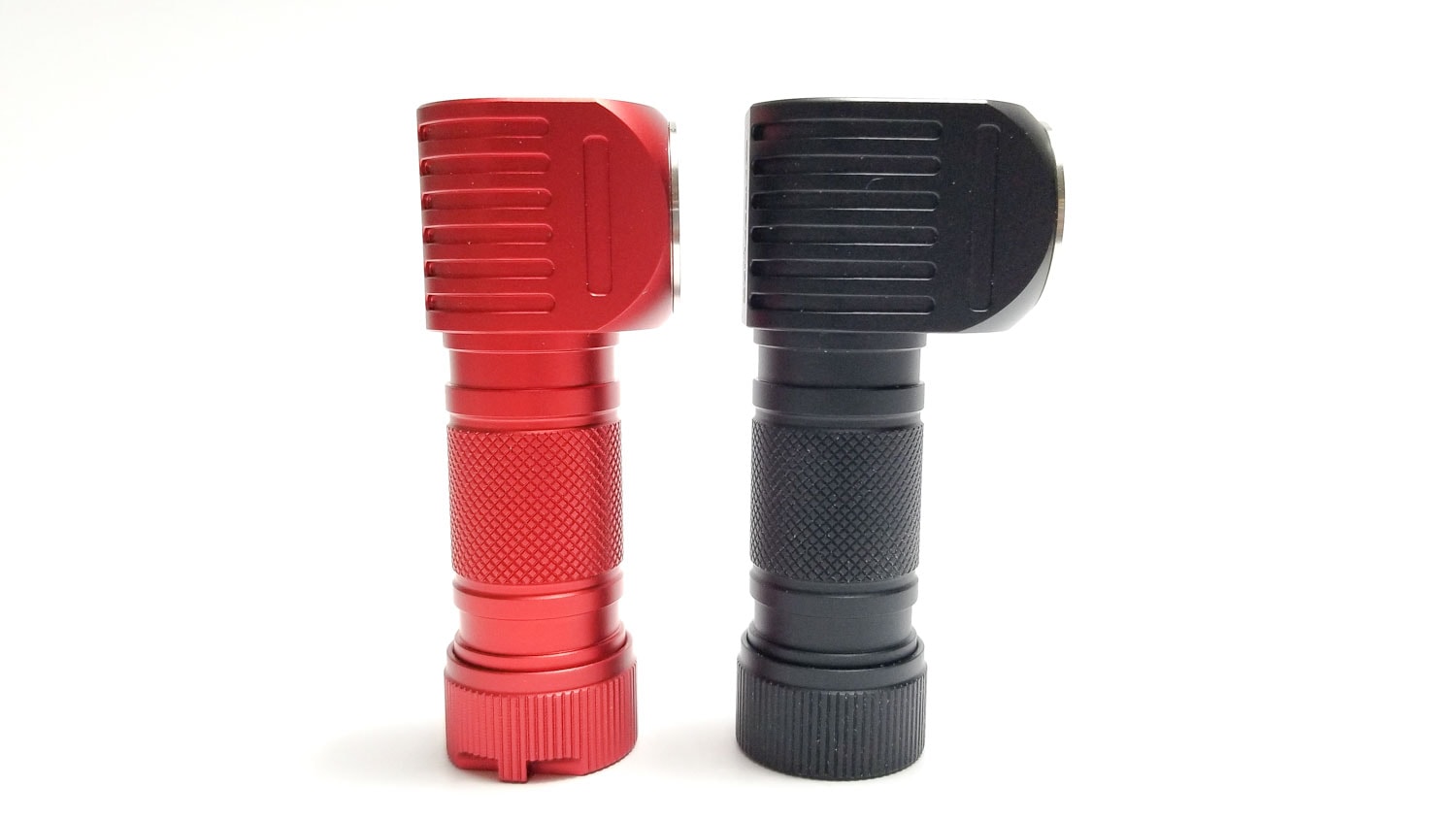
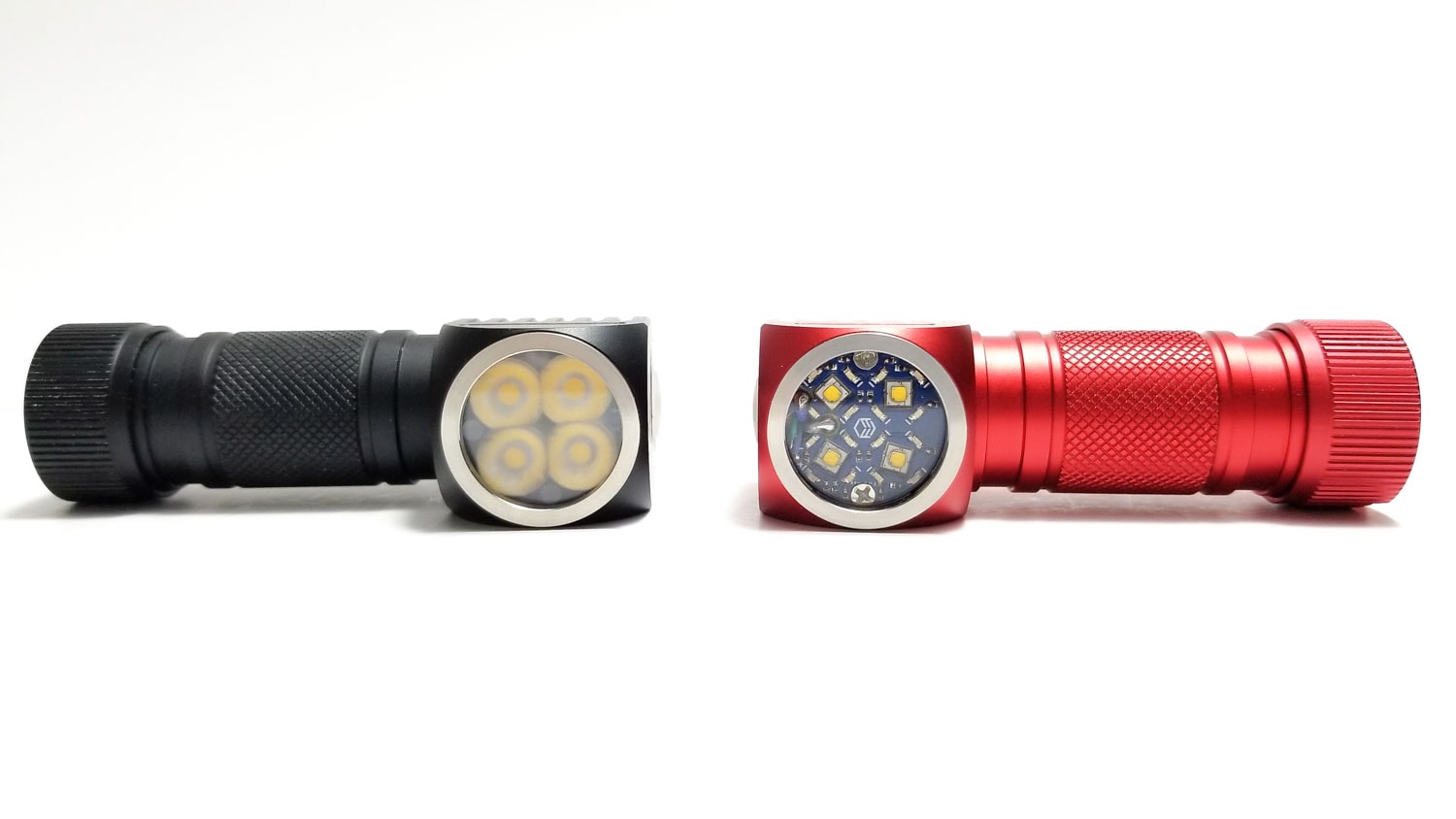
Driver & User Interface:
Since I can’t open up the PL47G2, I can’t tell you what’s under the hood, but since this is running Anduril, it’s probably an FET+1 driver, so you get all-out direct-drive on Turbo, and regulated output on lower modes.The driver is FireFlies design and looks to be 20 mm in diameter.
By default, it uses a smooth ramping mode.
Check out the full Anduril UI manual here.
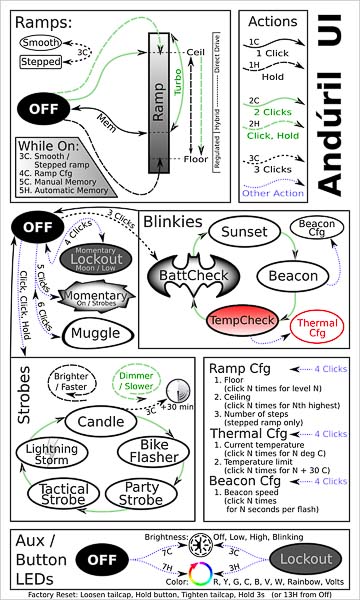
Keep in mind that the AUX LEDs are on by default. (7 clicks from OFF can change the AUX settings from On – Blink – Off)
From OFF:
- Single-click: ON
- Double click: High
- 3 clicks: Battery check
- 4 clicks: Lock Out
- 5 clicks: Momentary On
- 6 clicks: Muggle mode
- 7 clicks: Aux configuration mode
Enter Special/Fun modes from OFF:
- 2 clicks + hold: Strobe modes (Click, Click, Click and hold)
- 4 clicks: Lock Out mode (momentary on: dim)
- 5 clicks: momentary mode (Bright) ( you can only deactivate by breaking electrical contact between the batteries and the driver by unscrewing the body from the head.
- 6 clicks: Muggle mode
From ON:
- Single-click: Off
- Double click: Turbo
- 3 clicks: change ramping mode. Instead of a smooth increase, it has 6 little steps between Low and Max.
- 4 clicks: ramping configuration mode (Problematic if you make some changes here by accident)
- Press and hold: brightness ramps up.. release and press and hold again to ramp down.
SPECIAL AND FUN MODES:
Read the full manual on how to access and customize these modes. Also, see the firmware picture.
- Blinky Utility mode:
- Battery check
- Sunset Mode
- Beacon mode
- Temperature check
- Strobe / Mood modes:
- Candle
- Bike flasher
- Party strobe
- Tactical Strobe
- Lightning mode
- Lockout mode (can’t use the light) (activate by 4 clicks)
- Momentary mode (signaling/morse coding)
- Muggle mode: (safer for children)
- Configuration mode
- Ramp config mode
LOCK OUT FEATURE:
- From OFF: 4 clicks. To deactivate click another 4 times.
Additional info: Even though I like simple UI’s, I think Anduril is a good choice for the PL47G2. This is an enthusiast light so having the added customizability and feature set Anduril gives will appeal to a lot of users. It just works great and has a lot of features. Some like that, some don’t. I was expecting the thermal calibration to be off, and it was, but not as bad as some other Anduril lights I’ve come across. That said, you still want to calibrate it since the ambient temperature was a little low (maybe FireFlies calibrated it in a cold room?). I left it as-is for my tests since it wasn’t off much. This is all typical Anduril, so if you’ve owned an Anduril light, you’ll be at home with the PL47G2. The added benefit of Anduril here is apparent in the aux LEDs, namely, you can customize them (on or off, blinking, etc.). Pretty neat. Thanks ToyKeeper!
Batteries & Charging
The PL47 was designed around a 21700 size li-ion cell, but the G2 2021 edition introduced the short tube and the oddball 22430 lithium ion cell. At 22 mm in diameter by 43 mm long, it’s bigger than an 18350 with a little more capacity and about the same current-handling. FireFlies includes their high-drain 22430 cell advertised at 10 A discharge and 1850 mAh. The smaller cell will work fine, but if you want the most out of the light, opt for the 21700 tube since even a low-capacity 21700 like a 30T has almost double the capacity and triple the current-handling capability. I guess the 22430 cell is more for the EDC-role of the PL47, since you can’t use the short tube with the headband. Flat top and button top 21700’s worked, but I recommend to keep the length at or under 70 (+/- a couple mm’s) since protected cells are too long. No, 18650’s (save 70 mm long ones) don’t work.
There’s no onboard charging, so you need a standalone charger. For some this may be a deal-breaker, but for an enthusiast, no biggie. Pro tip: Any charger that works with a 16340 will work with the 22430 size cell, by the way, but keep the charge current at 1 amp to keep it happy (and living a long time).
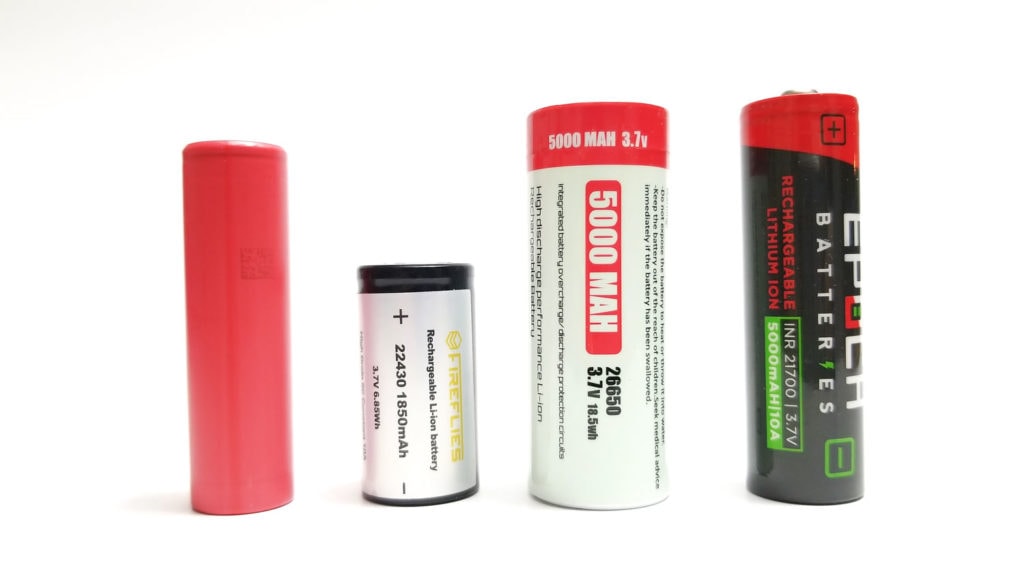
Performance
Here we go…another diminutive quad-emitter pocket light running Anduril behind an FET driver. Going to be hot and fast (temps and stepdowns, that is). I set the thermal limit to 70 C (maxxed out) for the testing to eliminate thermal throttling as a variable for the output.
Runtime graph
I conducted the runtime test using the 30 centimeter integrating sphere with the Digi-Sense 20250-00 data logging lux meter. I used the fully charged Epoch brand (rewrapped Samsung 50G) 5000 mAh 21700 battery and tested stepped modes 4, 6-7 and Turbo. I left out 5 because the readings were nearly identical to Level 6. No tests for the lowest 3 modes since they’d still be running when my Social Security becomes available.
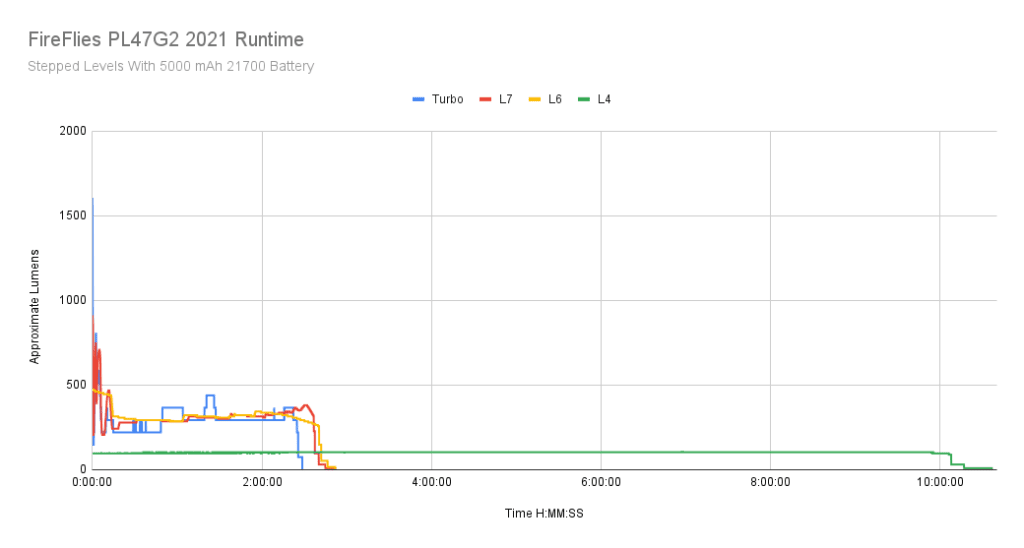
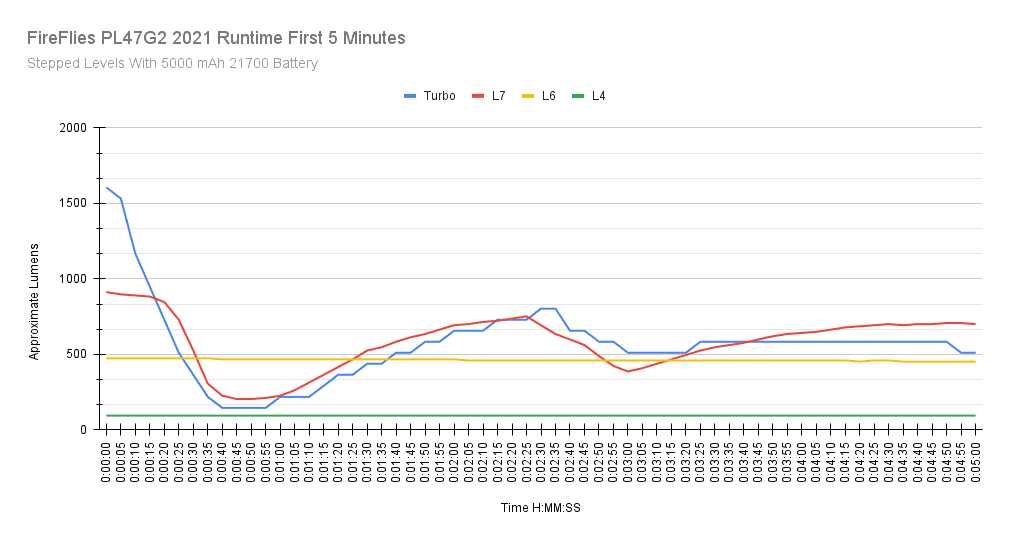
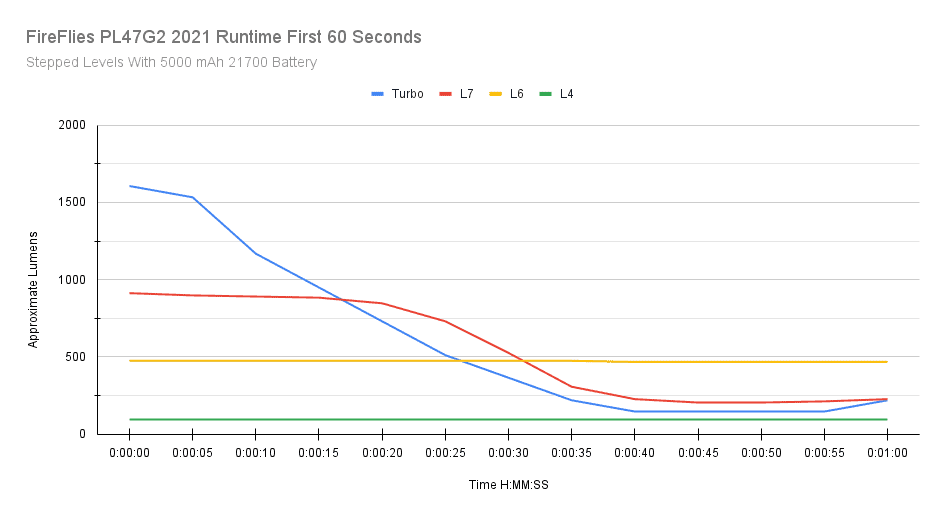
Turbo started at 1606 Lumens, way down from the FireFlies advertised of 2800. The light heated fast, up to 40 C within 10 seconds and up to 55 C by 20 seconds. That’s expected also. Within 30 seconds, output was down to just 365 Lumens (temps were 50 C) and kept falling, hitting only 146 Lumens at 40 seconds. As it cooled off, the output hit 803 Lumens by 2 minutes 35 seconds, and this continued for nearly the entire runtime until 6 minutes in when the output dropped and stayed between 438 and 219 Lumens for the remainder of the test. LVP kicked in at 2 hours 25 minutes, at which point I ended the test at 2 hours 28 minutes. Temps ran up to 70 C (the thermal limit).
Level 7 started at 912, stepping down by 211 by 55 seconds, and throttling up again like Turbo. It briefly hit 751 Lumens at 2 minutes 25 seconds, but generally was between 290 and about 320 Lumens the entire runtime. The thermal limit worked fine, as expected and the changes in brightness were barely noticeable throughout the runtime. Level 7 stepped down to under 100 Lumens at 2 hours 37 minutes, and LVP kicked in at 2 hours 44 minutes. I ended the test a short time later at 2 hours 55 minutes.
Level 6 started at 474.5 Lumens and was much more consistent, but the temperatures were nearly the same as Turbo and L7, it just heated up much more slowly (36 C vs 50 C for Turbo at 30 seconds). The output remained consistently over 400 Lumens for the first 13 minutes, decreasing to under 300 Lumens by 22 minutes and remaining between 292 and 320 Lumens for the next 2 hours and 7 minutes. The output dropped below 200 Lumens at the 2 hour 40 minute mark, and LVP pulled the reins in 6 minutes later and I ended the test at 2 hours 46 minutes.
Level 4 was downright boring. I usually let these tests run all day and night. Output stayed between 94 and 102 Lumens for over 10 hours, and LVP really kicked in at 10 hours 17 minutes, dropped the output very low (to the same level as the other modes), and I ended the test. Heating? Not really, I only saw a max of 38 C. I terminated the test after 10 hours and 36 minutes.
This is typical FET+1 driver and small host behavior. Heats up quickly and throttles like crazy at high modes, with long, regulated runtimes on the 7135 chip. I think this would be a lot better with the Loneoceans Lume1 driver since for a small host with limited heatsinking, a fully regulated driver is far better than an FET for consistent output. Oh well. Turbo is good for short runs, so like other pocket quads, the PL47G2 2021 is basically a 300-400 Lumen light most of the time (unless you like your hands extra crispy).
Lumen measurements (for each mode)
For the lumen tests, I used my home made 30 cm integrating sphere calibrated with a light of known output using the Digi-Sense 20250-00 data logging lux meter. Amps were measured with my Radio Shack TRMS multimeter with short 16 gauge wires inserted in the meter for currents under 5 amps, and my FY219 clamp meter and a 12 gauge wire loop for over 5 amps. I tested stepped levels 1-7 plus Turbo and used a Samsung 30T to give a good benchmark of the light’s potential. I tried the 22430 cell, and the readings were similar to the 30T until the FET took over. Level 7 was 4.5 A and Turbo hit 13.8 A at start.
FireFlies doesn’t list Lumen specs other than 2800 for the FA3 SST20 emitters. A firefly (depending on any one of the 170 species floating around out there) makes around 0.025 Lumens. With the 30T, I saw a hair under 1900 Lumens at start, and within 5 seconds, it was down to under 1600 Lumens. Even at start, these are wayyyy down from spec. I ran the 22430 cell also (30T numbers in parentheses) and there was a slight difference. Note the 10-minute numbers are on the 50G 5000 mAh cell, but I’d deduce the numbers would be similar with the 22430 and 30T.
| Mode | Amps at Start | Specs | @ Start | @ 30sec | @ 10min |
| 1 | 4 mA | ? | 1.36 | same | – |
| 2 | 28 mA | ? | 5.84 | same | – |
| 3 | 167 mA | ? | 40.88 | same | – |
| 4 | 467 mA | ? | 115.34 | 102.2 | 94.9 |
| 5 | 1.07 A | ? | 264.64 | 240.9 | – |
| 6 | 2.18 A | ? | 438 | 423.4 | 445.3 |
| 7 | 5.88 A | ? | 919.8 | 803 | 386.9 |
| Turbo | 20.8 A | 2800 lm | 1898 lm | 1679 lm | 292 |
Parasitic drain:
1 mA with the aux LEDs on, but only 14 microamps with them off.
Throw numbers:
Throw was measured at 5 meters indoors using the Uni-t UT383S lux meter. I used a Samsung 30T 21700 battery for all tests. Readings taken at 30 seconds. FireFlies doesn’t list throw or candela specs for the PL47G2. This light is not meant for throw, and the numbers confer this. In the real world, it’s good for about 150 meters, less if you run it on higher settings for longer than 30 seconds.
| Mode | Specs | Candela Measured | Meters |
| 1 | ? | N/A | N/A |
| 2 | ? | N/A | N/A |
| 3 | ? | 125 cd | 22 m |
| 4 | ? | 425 cd | 41 m |
| 5 | ? | 1075 cd | 66 m |
| 6 | ? | 1875 cd | 87 m |
| 7 | ? | 4200 cd | 130 m |
| Turbo | ? | 3,375 cd | 116 m |
| Turbo at start | 7525 cd | 173 m |
Beamshots
I compared the PL47G2 to some other headlamps and EDC lights and its mule counterpart (sans optics).
Outdoor shots: The fence is about 95 meters away. The PL47G2 is good for about 90-120 meters of useful illumination on Turbo, and much less on lower modes. It’s much better suited to EDC-type duties and as a worklight I think.
Indoors, the end of the hallway is about 12 meters. On the white walls, the tint is really rosy, but in real life it’s more natural-looking.
The wall with the map is about 4 meters away, and the PL47G2 easily lights up the whole office.
Flashlight beamshots:

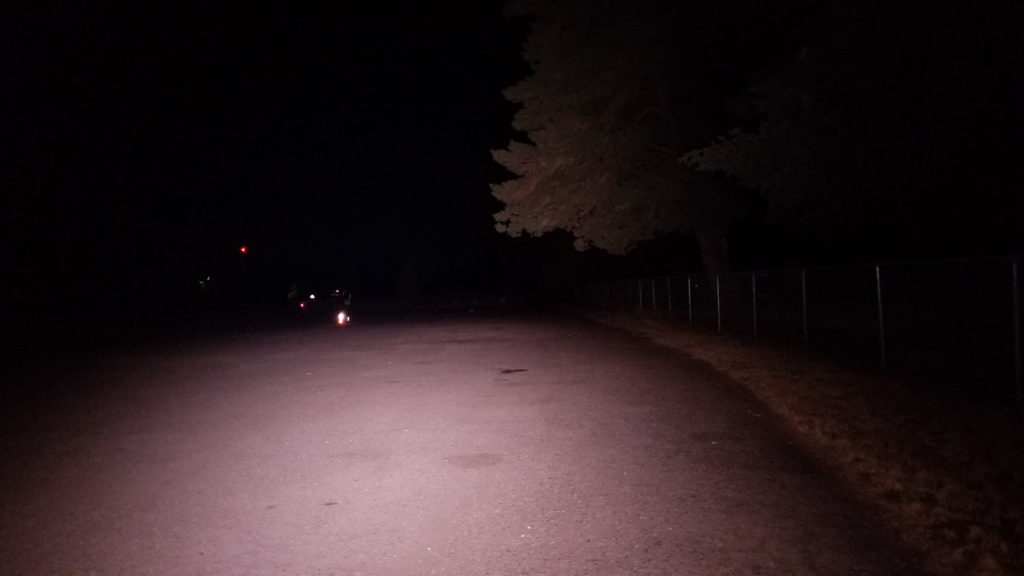


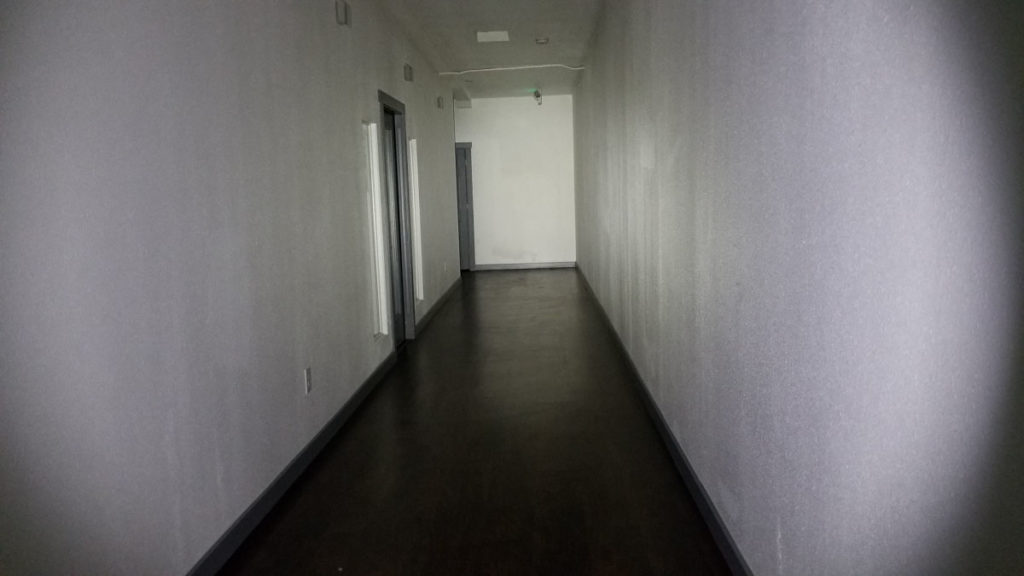
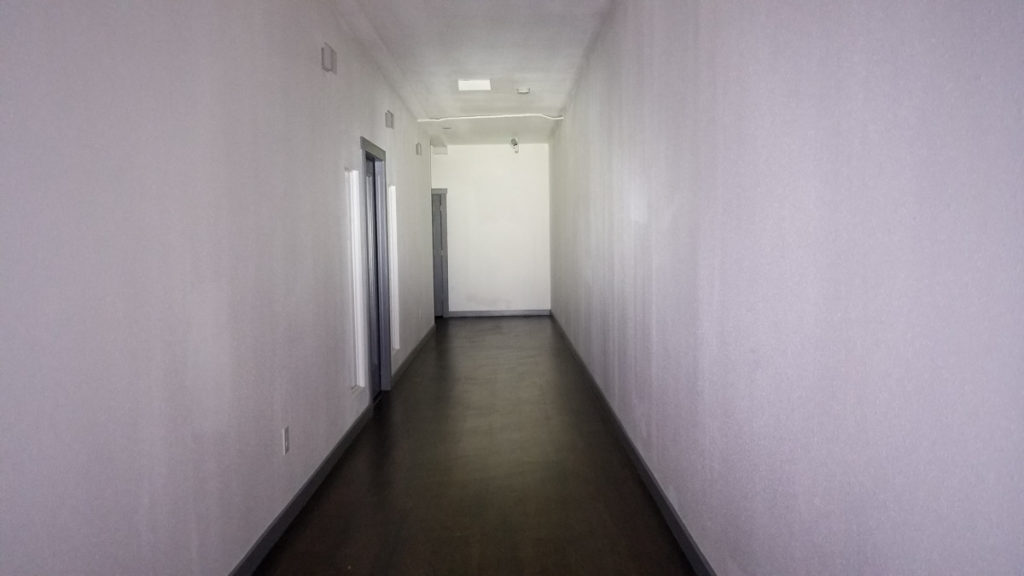
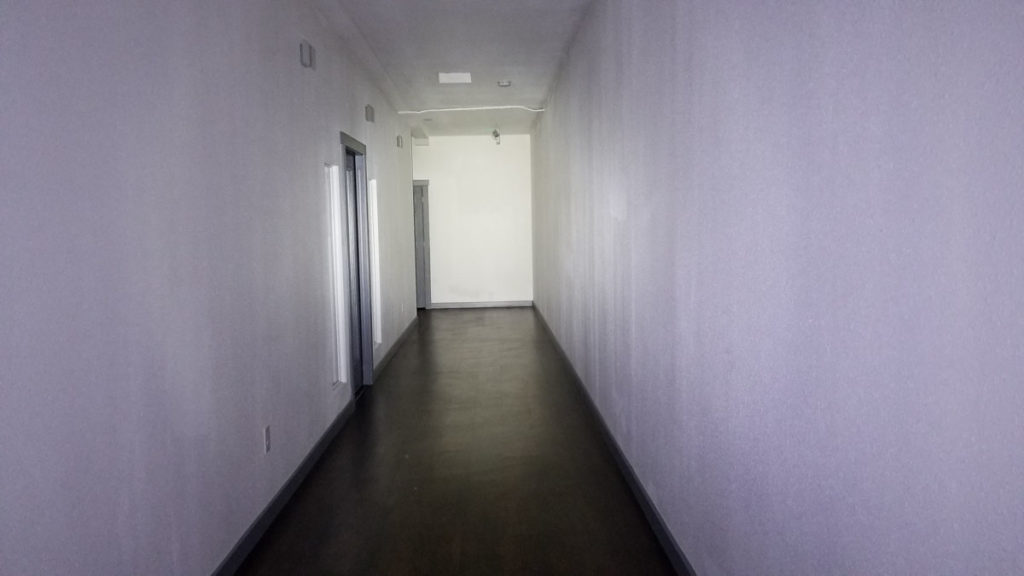
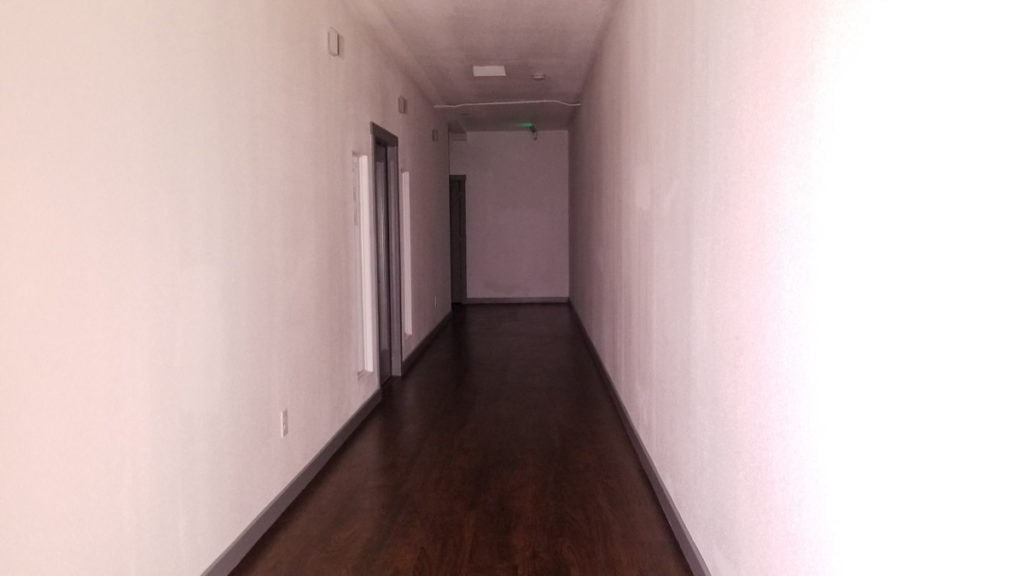


Disclaimer: This flashlight was sent to me for review at no cost by Fireflies. I have not been paid to review, nor have I been holding back on problems or defects.
Final Verdict
Pros
- Decent build quality
- Anduril UI
- Cool aux emitters and lighted switch
- Lots of emitter choices
- High output (briefly)
- Versatile beam
- Magnetic tailcap
- Versatile
Cons
- Very fast step down on higher settings
- Included lanyard is junky looking
- Gets expensive when optioned
- 22430 tube doesn’t work with headband or pocket clip
- Errant glue
- Didn’t meet output specs
Explanation on star ratings:
1: Avoid: my phone flashlight would be a better choice – 2: Poor: significant defect or issues, much better options available at the same price – 3: Average: some defects or issues – 4: Good: recommended (minor issues) – 5: Great: highly recommended

4 stars: ★★★★
I had a bit of a conundrum on my hands with the PL47G2, namely, is this a headlamp, worklight, or an EDC light? Really, I think it can fit any of those roles, but doesn’t really excel at them either. Almost like it doesn’t know what it wants to be when it grows up. Yes, you can carry it like a handheld light, and the right angle design makes it useful with the magnetic tailcap for DIY adventures. The addition of the short 22430 tube is great for EDC/pocket carry duty, and it’s awesome as a worklight since the magnetic tailcap sticks to metal things and the short tube helps it get into small spaces.
The 21700 tube and Anduril ups the versatility factor even more, with a wide range of outputs, smooth ramping, or stepped modes, and the ability to configure the temperature step down. It’s nice to stick it in the headband for headlamp duty as well (wished the short tube would fit). The build quality is good, and there’s a wide variety of emitter options to keep the tint-aficionados or Lumen chasers happy as well.
However, you can’t always have your cake and eat it too. It gets hot fast and steps down quickly on high settings, so that brings the practicality down a notch. I didn’t see 2800 Lumens from Turbo (even with a 30T), and the throw is not very good, although that may be due to emitter choice. High CRI is not conducive to high output. I think it’s a bit overpriced when you start adding options ($20 extra for XP-L’s?), and I don’t like the lanyard nonsense and the errant glue.
Despite those, I think FireFlies has sorted the “quality instabilities” (whatever they were) and delivered a highly versatile flashlight, or is it a headlamp? However you spin it, I’m giving 4 stars for the FireFlies PL47G2 2021 edition.
FireflyLite PL47G2 2021 for sale
Get 10% off at Firefly Outdoor store, using our exclusive discount code: 1lumen
1lumen selects and reviews products personally. We may earn affiliate commissions through our links, which help support our testing.